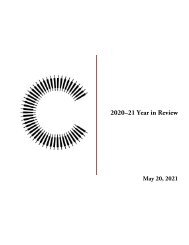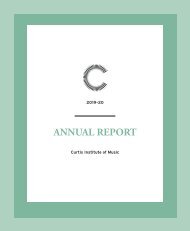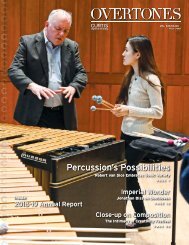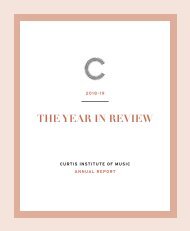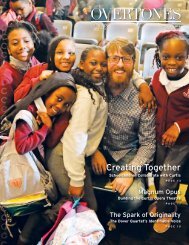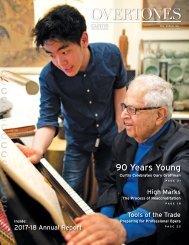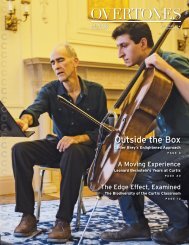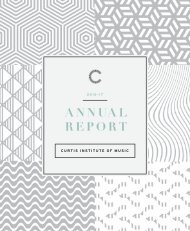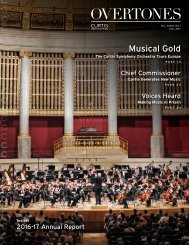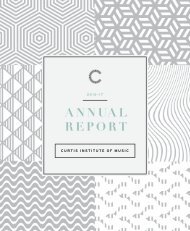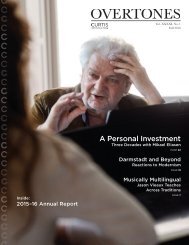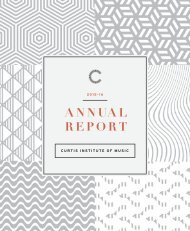Overtones: Spring 2017
Overtones is the semi-annual magazine of the Curtis Institute of Music. The latest issue highlights Curtis’s unique conducting fellows program, residencies by today’s leading composers, a compelling new way of presenting string quartets in performance, and more.
Overtones is the semi-annual magazine of the Curtis Institute of Music. The latest issue highlights Curtis’s unique conducting fellows program, residencies by today’s leading composers, a compelling new way of presenting string quartets in performance, and more.
Create successful ePaper yourself
Turn your PDF publications into a flip-book with our unique Google optimized e-Paper software.
MEET THE FACULTY<br />
Top left: Ms. Javian with ArtistYear Fellow Alize<br />
Rozsnyai (third from right) and her students in the<br />
choral program at South Philadelphia High School<br />
Top right: The student presenters of Curtis family<br />
concerts are coached by Ms. Javian, who makes<br />
a point of attending with her own children.<br />
PHOTO: DAVID SWANSON<br />
Watching Ms. Javian navigate<br />
her packed day, it’s striking<br />
how little time is wasted,<br />
yet how rarely she or her<br />
collaborators seem rushed.<br />
She keeps everyone<br />
focused with minimal<br />
hands-on direction.<br />
School, where she is teaching Suzuki violin. When Shannon recently sent out a text that<br />
the school had received an anonymous donation of violins, Ms. Javian responded that<br />
the news had “made her day.” “She just really cares about every project she’s doing,”<br />
Shannon says.<br />
This natural rapport with students extends, not surprisingly, to the heart of the matter:<br />
music. During breaks in the recording session she chats with violist Michael Casimir about<br />
orchestral excerpts. As she hears bassist Braizahn Jones improvising on a Stevie Wonder<br />
riff, she beams: “You keep playing all my favorite songs!” After the session has wrapped,<br />
she enlists Michael and a few other students to put the room back together. Everyone gets<br />
one last laugh, however, when Ms. Javian can’t quite follow the recording engineer’s mystical<br />
cable-coiling technique. “You’ll get it one day,” Michael teases her.<br />
CODA<br />
After the recording session wraps, Ms. Javian offers to take me, a first-time visitor, on a<br />
quick tour of Curtis’s main building, where all her lessons and rehearsals took place when<br />
she was a student. It’s like watching someone give a tour of their childhood home. We visit<br />
Field Concert Hall, onetime home to orchestra rehearsals, where the bass section would<br />
perch on one balcony, percussion on the other. We head upstairs to the practice rooms,<br />
where she shows me her class photo and the former bass studio just down the hall. She<br />
recalls the drudgery of hauling the basses off the rehearsal room platform, down the hall,<br />
and up the winding 19th-century staircase to that room, day after day.<br />
As we head out I suggest that maybe this is why she’s so quick to pitch in when it comes<br />
to the nitty-gritty—“lugging stuff,” as Ms. Javian puts it. She raises her eyebrows as if to<br />
agree but opts for disarming self-deprecation instead. “But I can’t even coil up a stupid<br />
cable!” she laughs.<br />
It seems that even the most accomplished arts leaders can still learn a thing or two.<br />
Perhaps this is Mary Javian’s greatest lesson of all. <br />
Ian VanderMeulen is a freelance writer and musician whose work has appeared in Symphony and<br />
Musical America. He lives in New York, where he is pursuing his doctorate at New York University.<br />
PHOTO: DAVID SWANSON<br />
WHY CHOOSE CURTIS?<br />
—Mary Javian<br />
More Reasons at<br />
www.curtis.edu/WhyChooseCurtis<br />
“For so long, I felt like the answer to that question was simply: ‘Because it’s the best.’ And<br />
now I actually think it’s: ‘Because it’s the most nurturing environment in which an artist can<br />
grow, and explore what works for them.’ Because of the size, because of the student-teacher<br />
ratio, and because of the huge range of performance opportunities and projects that<br />
students can pursue, [including] community engagement, support for entrepreneurial ideas.<br />
And the faculty … I think they’re amazing. The culture here is extremely nurturing in a way<br />
that’s really unique.”<br />
8 OVERTONES SPRING <strong>2017</strong>



